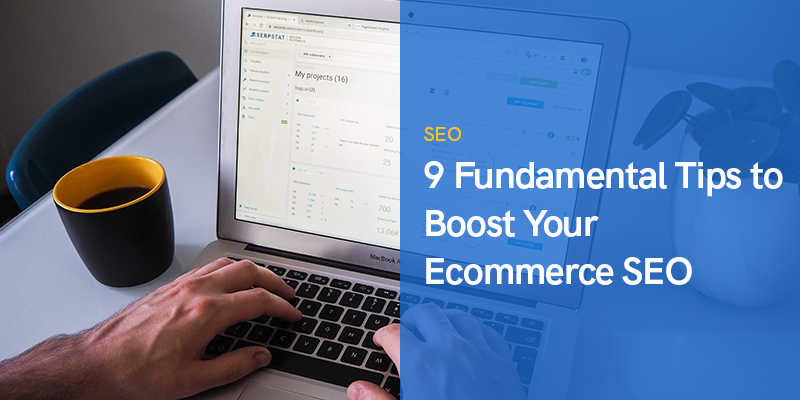
9 Fundamental Tips to Boost Your Ecommerce SEO
It’s no secret that for your ecommerce website to attract more visitors and paying customers, you need search engine optimization (SEO).
No matter what niche you’re in, optimizing your site for SEO can ultimately help your business become more profitable.
Contrary to what most people think, you don’t need to implement complicated, massive campaigns to see big results for your brand. According to a Google article, even small changes can lead to noticeable gains over time.
Ready to take your ecommerce business forward with SEO? In this article, you will learn 9 tried-and-true tips you can use starting today.
9 Fundamental Tips to Boost Your Ecommerce SEO
Follow these strategies:
Perform Keyword Research
Keyword research is a basic ingredient for a website’s success, ecommerce or not.
You have two options for keyword research. One is to begin from scratch and the other is to look at your top competitors in the same niche. Regardless, pay attention to aspects like:
- Search volume
- Keyword competitiveness or difficulty
- Relevance of those keywords to your website
Already have tons of pages on your ecommerce site? I recommend doing this: Identify your most important pages and map the keywords to those pages first. Assign a primary keyword to that page, and then long-tail keywords.
Aim for E-A-T Quality

E-A-T stands for Expertise, Authority, and Trust. Google will see your website as high in quality if you meet their E-A-T standards.
This is especially important if you have YMYL (Your Money or Your Life) pages – these are pages that impact your audience’s happiness, safety, and finances.
Here are some useful suggestions for ecommerce sites:
- Work only with reputable manufacturers.
- Make sure that your product pages contain all the necessary information. This includes delivery charges/costs, FAQs, contact information, product support, etc.
- Get mentioned or reviewed by reputable experts.
- Increase the security of your checkout pages.
Build Links to Your Website
With SEO for ecommerce, link building is still a powerful tactic to rank higher, increase your organic traffic, and outperform the competition.
One way to build links is to check what sites are already linking to your competitors. These sites will also be more likely to link to you. Reach out to them through email.
Another idea is to have an influencer review your product. Send over your product, let them write an honest and detailed review, and then link to your site. This way, you don’t just get a link, but also potential customers.
Finally, make it a priority to write link-worthy content. This refers to content that provides real value. It educates, inspires, and solves your audience’s problems.
Write SEO-Friendly Product Descriptions
The goal of every product description is to help customers understand what your product is all about.
If done right, it can generate a sale because your customer can make an informed buying decision. When it comes to search engines, well-written descriptions make your products rank higher.
The number 1 rule is to write for your customers. Ask important questions like: Who will be using this product? What is this product useful for? How is it better than the competition?
Include the main features and benefits of the product. Features are the technical details of your product, while benefits are the ways your product improves their lives.
Speed up Your Website

Your ecommerce site may look great, but if the pages load slowly, it’s less likely to get conversions.
Google also announced that it will be rolling out its Core Web Vitals in May 2021. This prioritizes a user’s page experience, which obviously includes speed.
Here are ways to increase the speed of your pages and boost your site’s overall performance:
- Choose a fast ecommerce platform and web hosting.
- Reduce your HTTP requests by reducing image file sizes, removing useless images, and loading JavaScript asynchronously.
- Use a CDN or Content Delivery Network.
Tools like PageSpeed Insights and GTmetrix should help you check your site’s current speed performance and make recommendations.
Fix Duplicate Content Issues
Duplicate content is common on ecommerce sites with too many pages already.
This happens when pages contain the exact same (or similar) blocks of text. For example, multiple variations of the same product.
You might think duplicate content is harmless, but it can actually damage your rankings. Instead of your priority pages, Google tries to pick which page version to rank.
Make sure to run a site audit to check for duplicate content. You can use tools like Screaming Frog and Copyscape to identify issues.
If you find such pages, set up canonical tags to tell Google which page is the original one and that you’d like to appear in search results.
Create Useful Content that Satisfies Your Buyers
Google loves content that educates and engages your target audience. Before writing content, you must understand who your buyer is.
I recommend starting with a buyer persona. Here are the things you should know about them:
- Demographics (Age, gender, income, location, etc.)
- Interests, hobbies
- Pain points
- Where they hang out online
Doing keyword research also helps you hone in on your audience by providing you with insights into their needs.
Also, find out what content format they prefer. Do they like watching videos? Including these on your site will make it more discoverable.
Make Your Site Architecture User-Friendly
Structure your ecommerce site simply.
Users love it when they can make just a few clicks to find the products they want. Another benefit of using a flat site structure is that Google will be able to index all your pages.
So, don’t complicate things. To prevent your site from getting messy, especially if your site is huge, create categories and subcategories.
Also, create a sitemap. This will enable you to visualize everything and ensure that your site is crawled and ranked accordingly.
Have an Internal Linking Strategy

We’ve discussed acquiring links from other reputable sites. Internal linking, or linking from one page to another within your site, matters too.
Internal links contribute to your site architecture as well as help visitors discover more of your content.
When doing so, make sure that you only link to relevant pages. For example, linking to your fitness tracker product page from your article on choosing the right fitness tracker.
During your SEO audit, you’ll also want to check for orphaned pages. These are important pages on your site that have no internal links. Figure out which pages can potentially link to them.
Final Thoughts
Start improving your SEO with these tips. And while you’re at it, set and track important key performance indicators (KPIs) to measure your success. Such KPIs include your website traffic, rankings, click-through rate, links, conversions, and bounce rate.
Hopefully, you’ve learned from this post and will take action.
Recommended Posts

How to Earn Authority Backlinks for Your Website?
November 29, 2023

How to Optimize Your Website for Voice Search in 2024
November 14, 2023

UX and SEO as Your Key Players: 8 Tips to Web Success Blueprint
October 24, 2023